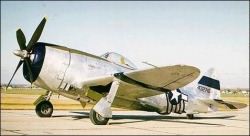| Interview: Jack Morgan CAF by Leonard "Viking1" Hjalmarson |
||||
|
As I indicated before, we loved the AT-6. It was a joy to fly, but if you mistreated it, it could reach up and bite-cha. And, oooh, how it loved to loop...on the ground as well as in the air. It was a good airchine to train in before going to the hot stuff and I think we all look back on her with misty eyes. I sailed through the learning of flying without too much trouble and finally came the last days before graduation. The authorities asked us to list our first three choices for fighters. Not that we would get what we asked for, but so they could figure out which ones we would NOT get! I listed choice one as the beautiful P-51, choice two as the P-38, and I didn't even list the P-47 as a choice. I wanted nothing to do with that ugly old monstrosity. They sent me to a place more remote than that place of my childhood...Wendover Field, Utah...126 miles from habitation! To learn to fly - you guessed it - the P-47 Thunderbucket. By the time I had about a hundred hours in the 'Bolt, I was taking a grudging respect and admiration for it and by the time I was ready for overseas duty I kinda liked having that 2,000 horsepower, R-2800 engine out in front of me. CSim: What was life like in the combat squadron? Well, it was pretty spartan, but we lived right on one of the finest beaches in Italy. Of course it was in war-damaged houses with no window glass no heaters other than the ones we built ourselves and fueled with 100-octane gas. No sleeping bags, just three GI blankets and our fur-lined flying suits. Once it became spring, we spent our spare time on the beach and forgot the living conditions.. Our operations was in a huge old combination farmhouse/barn, with the greasy fingernails operations downstairs in the barn and our operations offices upstairs. We had a 4,600' strip that was half paved and half pierced-steel planking. There were three P-47 squadrons there, the 64th (mine), the 65th and the 66th. We had a lot of comraderie between them, but a good bit of competition, as well. CSim: Many of these squadrons had some eccentric characters. Where there any who stood out? There were a lot of characters in the unit, but the one that stands out in my memory was one of the quietest, most unassuming and likeable man I think I have ever known. He did not drink, smoke, cuss or chew. I first noticed him when I sat down to eat my first meal after arriving to the 64th. |
While all the rest of us were "diggin' in," he was saying grace. While I - and most of the rest of them - were hoisting a few at the bar, he was either in the back of what we laughingly called the officers club, or in his room reading or studying. He was also the first of his class to become element leader, then flight leader, because he was so reliable and so calm in just about any circumstance. And he could fly! I'm happy to say Kitowski (we called him "Kit," of course) survived the war and is living on a lake in a high dollar home near Austin, Texas. He was just as successful in civilian life as in the military. CSim: Tell us about your first combat experience. I really don't remember too many particulars. It was frightening, of course, but as I learned later, this was a rather generic mission. Go up, dive bomb a bridge, get shot at a few times (that was pretty exhilerating, seeing all those tracers going past you like angry bees), straf the area and go out looking for targets of opportunity...of which we found none. I do remember that I got my first taste of 88mm fire. They would come up to approximately your altitude and explode, leaving two round puffs of black smoke...sorta like a figure 8. And if they got fairly close you could even hear them. It was more of a "whomp" than an explosive bang. Just about like that a large exploding fireworks makes when it explodes and makes all the little stars. Except the 88mm showered out shrapnel. We dove and turned and never got hit that day. One lesson I learned was that a wing man kept his eyes in the air! I called out something suspicious on the ground, and I got called a few names by the flight leader. Our job was to stay on the wing of our number one or two man in the flight, and to weave back and forth so we could see behind and above us. I soon found that a silk scarf is a necessity to keep one's neck from being chaffed from all the head twisting. Go to Part III
|
|||
|
© 1997 - 2000 COMBATSIM.COM, INC. All Rights Reserved. Last Updated November 13th, 1998 |
||||


